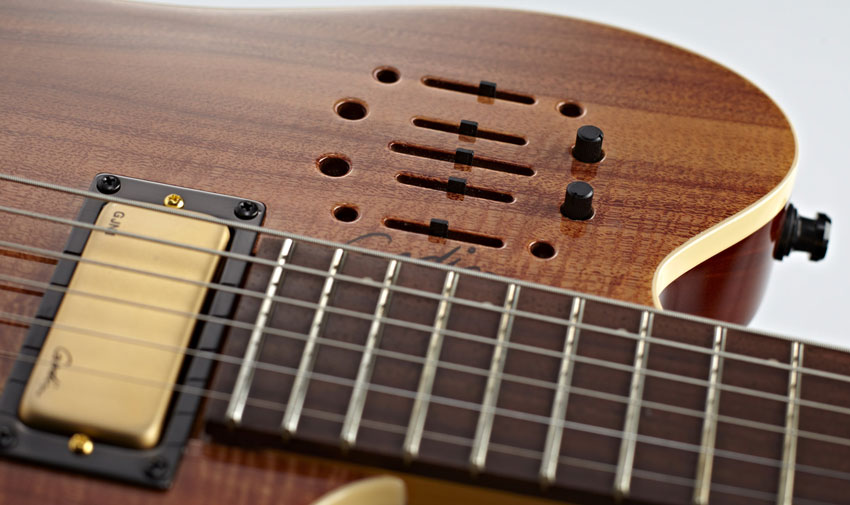MusicRadar Verdict
Overall, a serious tool for the creative musician that's well worth trying.
Pros
- +
Electric-like neck is very playable. Wide variety of tones and applications on offer. Huge amount of control.
Cons
- -
Not much.
MusicRadar's got your back

Godin Acousticaster 40th Anniversary Koa

Controls

Bridge
Despite starting to build Norman guitars in 1973, it wasn't until 1987 that Robert Godin launched his first own-brand instrument: a thinline Telecaster-shaped electro-acoustic with an 'internal harp': the Acousticaster.
Construction-wise, this new Anniversary model is very similar to the original Acousticaster: a mainly hollow chambered body with cedar top that, here, is faced with a rather fetching koa veneer. The thin top is braced like an acoustic, but the difference is in the form of the 18 tuned metal 'tines', or prongs, that stick out from a spruce brace placed under the acoustic-like pin bridge. The idea is that they continue the energy of the strings and compensate for the relatively small acoustic chamber.
"This is an electro-acoustic that wants to reach out for lower volume electric duties, too"
The shape has evolved, too, from the original - the bass-side shoulder is pulled out a little. It's less Fender, more Godin. That said, the maple bolt-on neck feels more Fender than Taylor, and certainly feels very electric-like; the fretting is tidy, and there's even a slight rollover to the fingerboard edges.
Pickup-wise, we have an under- saddle piezo pickup and, new to the Acousticaster, a neck-placed mini-humbucker. This is an electro-acoustic that wants to reach out for lower volume electric duties, too. This duality is easily handled via the control panel - which also acts as a series of soundholes. We have volume for each of the pickup sources, plus treble, midrange and bass slider controls for the piezo.
Two smaller rotaries at the top of the panel operate treble and bass EQ for the magnetic neck pickup. Then we have two (unlabelled) jack outputs: output 1, furthest from the base strap button, is the regular magnetic out; output 2 is a mono mix of the piezo and magnetic signals. However, use two mono leads and you can send your magnetic pickups, via output 1, to your guitar amp, and the piezo acoustic sound, via output 2, to an acoustic amp or PA.
There's a spacious, sustaining but relatively quiet unplugged acoustic-like resonance, and it's strung with nickel-wound 'electric' strings to take full advantage of the magnetic neck pickup. Plugged in, the electro-acoustic sound is highly credible, with plenty of control to thin mids and tame crispy highs.
Conversely, the neck humbucker sounds quite bluesy and jazzy into an acoustic amp - quite 'hollowbody'. Mix in a little of the acoustic sound and you have a more contemporary jazz tone à la Pat Metheny. It works well into a clean guitar amp, and with dual amps, the fun really starts.
Want all the hottest music and gear news, reviews, deals, features and more, direct to your inbox? Sign up here.
Two guitars in one? And a few more besides. Suddenly, that price looks easier to justify.
Dave Burrluck is one of the world’s most experienced guitar journalists, who started writing back in the '80s for International Musician and Recording World, co-founded The Guitar Magazine and has been the Gear Reviews Editor of Guitarist magazine for the past two decades. Along the way, Dave has been the sole author of The PRS Guitar Book and The Player's Guide to Guitar Maintenance as well as contributing to numerous other books on the electric guitar. Dave is an active gigging and recording musician and still finds time to make, repair and mod guitars, not least for Guitarist’s The Mod Squad.
